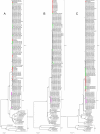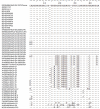Human adenovirus type 4 (HAdV-4) associated acute respiratory tract infection in children & genetic characteristics of HAdV-4 in China: a prospective multicenter study
- PMID: 39251906
- PMCID: PMC11385803
- DOI: 10.1186/s12879-024-09835-7
Human adenovirus type 4 (HAdV-4) associated acute respiratory tract infection in children & genetic characteristics of HAdV-4 in China: a prospective multicenter study
Abstract
Background: Human adenovirus (HAdV) is an important pathogen causing acute respiratory infection (ARI) in children. Many countries, including China, have experienced sporadic or outbreaks related to HAdV-4, and death cases were reported. However, there is little research on HAdV-4 and the epidemic situation of HAdV-4 in China is little known. This study was designed to comprehend the prevalence and genetic characteristics of HAdV-4 in ARI children in China.
Methods: Respiratory tract samples from ARI children hospitalized in six hospitals of Northern and Southern China from 2017 to 2020 were collected for HAdV detection and typing. Clinical information was collected from HAdV-4 positive patients for clinical characteristics and epidemiological analysis. The main capsid proteins and the whole genome sequences were amplified and sequenced for bioinformatics analysis.
Results: There were 2847 ARI children enrolled, and 156 (5.48%) HAdV positive samples were detected. Eleven HAdV-4 positive samples were identified, accounting for 0.39% of the total samples and 7.05% of the HAdV positive samples. The main manifestations were fever and cough. Two children had conjunctivitis. Two children were diagnosed with severe pneumonia and developed respiratory failure. One of them developed hemophagocytic syndrome and checked in pediatric intensive care unit (PICU). This child had ventricular septal defect. All the children recovered. The isolated strains of HAdV-4 obtained in this study and the reference strains from China located in the same phylogenetic branch (HAdV-4a), while the prototype strain and vaccine strains formed another branch (HAdV-4p). Upon comparison with the prototype strain, there were a few amino acid mutations existing in three major capsid proteins. According to recombination analysis, no new recombination was found.
Conclusions: The detection rate of HAdV-4 in children hospitalized with ARI was 0.39% in the total samples and 7.05% of all HAdV positive samples. HAdV-4 isolates obtained in this study and other reference strains from China belonged to the HAdV-4a subtype. Our data provided reference for the monitoring, prevention and control of HAdV-4, as well as the research and development of vaccines and drugs.
Keywords: Acute respiratory infection; Children; Clinical characteristics; Genetic characteristics; Human adenovirus type 4.
© 2024. The Author(s).
Conflict of interest statement
The authors declare no competing interests.
Figures




Similar articles
-
Epidemiological characteristics of adenovirus in children in Yancheng, China, 2023-2024.Front Cell Infect Microbiol. 2025 May 29;15:1587257. doi: 10.3389/fcimb.2025.1587257. eCollection 2025. Front Cell Infect Microbiol. 2025. PMID: 40510801 Free PMC article.
-
Molecular Identification and Epidemiological Features of Human Adenoviruses Associated with Acute Respiratory Infections in Hospitalized Children in Southern China, 2012-2013.PLoS One. 2016 May 12;11(5):e0155412. doi: 10.1371/journal.pone.0155412. eCollection 2016. PLoS One. 2016. PMID: 27171486 Free PMC article.
-
Comparative analysis between genotypes of adenovirus isolates from hospitalized children with acute respiratory tract infections and clinical manifestations in Wuhan, China, from June 2022 to September 2023.Virol Sin. 2025 Feb;40(1):50-60. doi: 10.1016/j.virs.2024.12.004. Epub 2024 Dec 20. Virol Sin. 2025. PMID: 39710326 Free PMC article.
-
Clinical features of HAdV-55 in children with respiratory tract infections: a retrospective case series and literature review.BMC Infect Dis. 2025 Apr 17;25(1):553. doi: 10.1186/s12879-025-10890-x. BMC Infect Dis. 2025. PMID: 40247166 Free PMC article. Review.
-
Prevalence of human infection with respiratory adenovirus in China: A systematic review and meta-analysis.PLoS Negl Trop Dis. 2023 Feb 22;17(2):e0011151. doi: 10.1371/journal.pntd.0011151. eCollection 2023 Feb. PLoS Negl Trop Dis. 2023. PMID: 36812245 Free PMC article.
Cited by
-
Epidemiological characteristics of adenovirus in children in Yancheng, China, 2023-2024.Front Cell Infect Microbiol. 2025 May 29;15:1587257. doi: 10.3389/fcimb.2025.1587257. eCollection 2025. Front Cell Infect Microbiol. 2025. PMID: 40510801 Free PMC article.
References
-
- Li H, Mao NY, Yu PB, Yin J, Jiang HB, Zhang B, et al. Genetic characteristics of human adenovirus type 4 in acute respiratory tract infection in four provinces of China from 2013 to 2014. J Virol. 2018;34(06):850–9. 10.13242/j.cnki.bingduxuebao.003463. (in Chinese).10.13242/j.cnki.bingduxuebao.003463 - DOI
-
- Madisch I, Harste G, Pommer H, Heim A. Phylogenetic analysis of the main neutralization and hemagglutination determinants of all human adenovirus prototypes as a basis for molecular classification and taxonomy. J Virol. 2005;79(24):15265–76. 10.1128/JVI.79.24.15265-15276.2005. 10.1128/JVI.79.24.15265-15276.2005 - DOI - PMC - PubMed
-
- Madisch I, Hofmayer S, Moritz C, Grintzalis A, Hainmueller J, Pring-Akerblom P, et al. Phylogenetic analysis and structural predictions of human adenovirus penton proteins as a basis for tissue-specific adenovirus vector design. J Virol. 2007;81(15):8270–81. 10.1128/JVI.00048-07. 10.1128/JVI.00048-07 - DOI - PMC - PubMed
-
- Dongliu Y, Guoliang Y, Haocheng X, Shuaijia Q, Li B, Yanglei J, et al. Outbreak of acute febrile respiratory illness caused by human adenovirus B P14H11F14 in a military training camp in Shandong China. Arch Virol. 2016;161(9):2481–9. 10.1007/s00705-016-2949-x. 10.1007/s00705-016-2949-x - DOI - PMC - PubMed
Publication types
MeSH terms
Substances
Grants and funding
LinkOut - more resources
Full Text Sources

